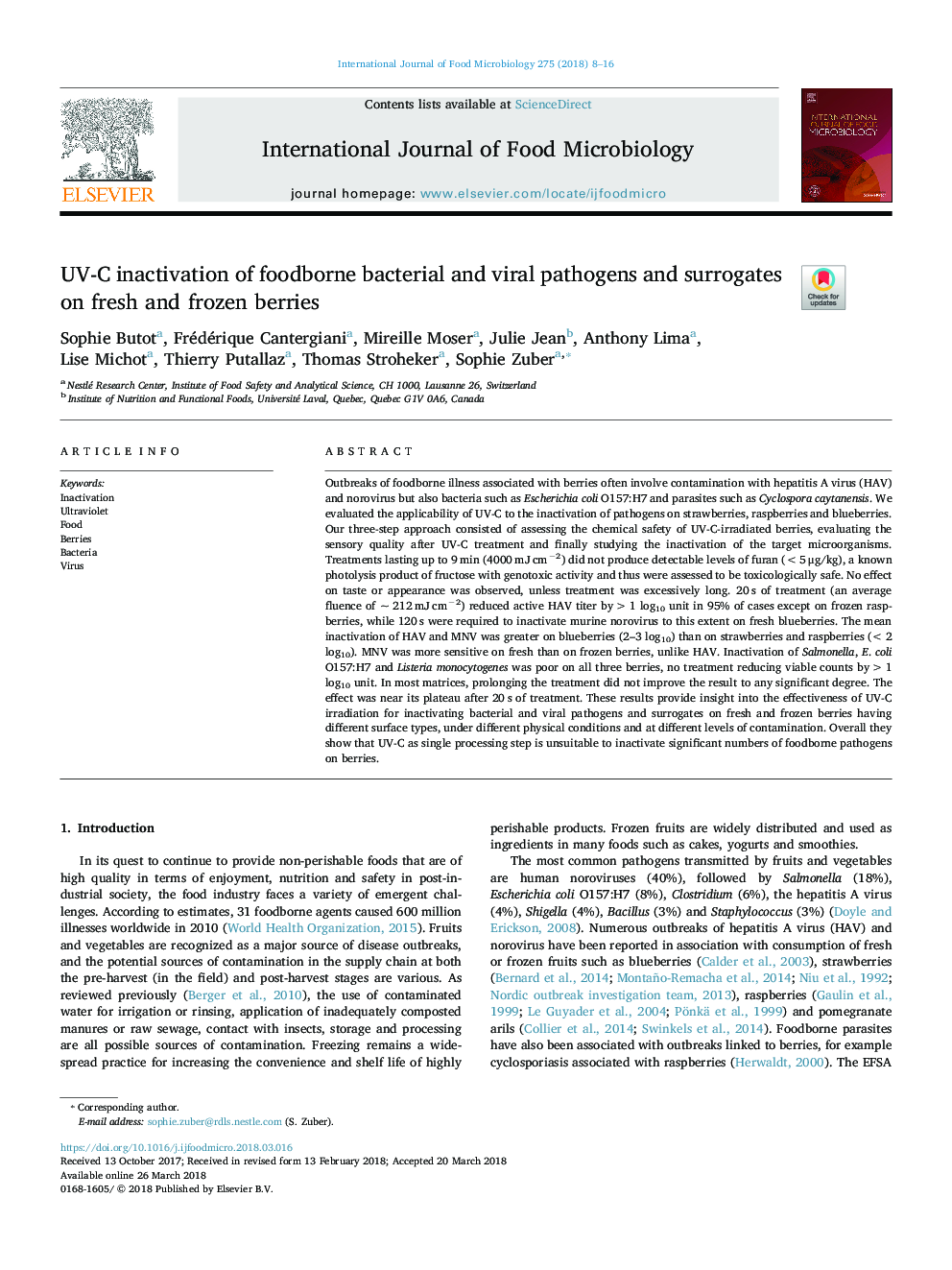| کد مقاله | کد نشریه | سال انتشار | مقاله انگلیسی | نسخه تمام متن |
|---|---|---|---|---|
| 8844196 | 1616508 | 2018 | 9 صفحه PDF | دانلود رایگان |
عنوان انگلیسی مقاله ISI
UV-C inactivation of foodborne bacterial and viral pathogens and surrogates on fresh and frozen berries
دانلود مقاله + سفارش ترجمه
دانلود مقاله ISI انگلیسی
رایگان برای ایرانیان
کلمات کلیدی
موضوعات مرتبط
علوم زیستی و بیوفناوری
علوم کشاورزی و بیولوژیک
دانش تغذیه
پیش نمایش صفحه اول مقاله

چکیده انگلیسی
Outbreaks of foodborne illness associated with berries often involve contamination with hepatitis A virus (HAV) and norovirus but also bacteria such as Escherichia coli O157:H7 and parasites such as Cyclospora caytanensis. We evaluated the applicability of UV-C to the inactivation of pathogens on strawberries, raspberries and blueberries. Our three-step approach consisted of assessing the chemical safety of UV-C-irradiated berries, evaluating the sensory quality after UV-C treatment and finally studying the inactivation of the target microorganisms. Treatments lasting up to 9â¯min (4000â¯mJâ¯cmâ2) did not produce detectable levels of furan (<5â¯Î¼g/kg), a known photolysis product of fructose with genotoxic activity and thus were assessed to be toxicologically safe. No effect on taste or appearance was observed, unless treatment was excessively long. 20â¯s of treatment (an average fluence of ~ 212â¯mJâ¯cmâ2) reduced active HAV titer by >1 log10 unit in 95% of cases except on frozen raspberries, while 120â¯s were required to inactivate murine norovirus to this extent on fresh blueberries. The mean inactivation of HAV and MNV was greater on blueberries (2-3 log10) than on strawberries and raspberries (<2 log10). MNV was more sensitive on fresh than on frozen berries, unlike HAV. Inactivation of Salmonella, E. coli O157:H7 and Listeria monocytogenes was poor on all three berries, no treatment reducing viable counts by >1 log10 unit. In most matrices, prolonging the treatment did not improve the result to any significant degree. The effect was near its plateau after 20â¯s of treatment. These results provide insight into the effectiveness of UV-C irradiation for inactivating bacterial and viral pathogens and surrogates on fresh and frozen berries having different surface types, under different physical conditions and at different levels of contamination. Overall they show that UV-C as single processing step is unsuitable to inactivate significant numbers of foodborne pathogens on berries.
ناشر
Database: Elsevier - ScienceDirect (ساینس دایرکت)
Journal: International Journal of Food Microbiology - Volume 275, 20 June 2018, Pages 8-16
Journal: International Journal of Food Microbiology - Volume 275, 20 June 2018, Pages 8-16
نویسندگان
Sophie Butot, Frédérique Cantergiani, Mireille Moser, Julie Jean, Anthony Lima, Lise Michot, Thierry Putallaz, Thomas Stroheker, Sophie Zuber,